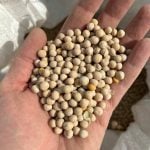By Commodity News Service Canada
WINNIPEG, Aug. 22 (CNS Canada) – Pea harvest is almost complete in Manitoba, according to the latest crop report for the week ending Aug. 21.
The pea harvest in the southwest region is nearly complete with above average yields and good quality reported.
In the northwest, producers are taking off some pea and lentil crops with pea yields ranging from 60 to 80 bushels/acre.
In the central region, pea yields are reported as being about 50 per bu./acre with harvest complete. Also in central Manitoba, there are reports of leaf drop in dry edible beans because of drier conditions. Timely rains could benefit seed size and boost quality.
Read Also
Pulses: Frost damage reported in Victoria
By Dave Sims, Commodity News Service Canada Winnipeg, January 19 (CNS) – The USDA has raised its production estimates for…
India’s total pulse production outlook for 2016-17 has been increased by 550,000 tonnes to 22.95 million tonnes, a 40 per cent increase from 2015-16 (6.6 million tonnes more) and 5.32 million tonnes higher than the five year average.
India released its fourth seasonal estimate for several crops with total food grains production at a record 275.68 million tonnes, up 2.3 million tonnes from the last estimate released in May, and 24.1 million tonnes higher than 2015-16.
The latest estimate for the summer or kharif crop was projected to climb to 9.4 million tonnes, an increase of 300,000 tonnes from the May estimate.
The estimate for the larger rabi (winter) crop was increased by 240,000 tonnes since May.
Data from the India government show pulse plantings were at 32.3 million acres, down 3.5 per cent from the same date a year ago.
Meanwhile the Indian government also moved shipments of urad and moong dal under a restricted category, limiting imports to 300,000 tonnes. The government hopes to support domestic prices by limiting imports. Domestic prices have fallen below India’s minimum support levels. India produced 2.07 million tonnes of moong dal in 2016-17, a record for the crop, compared to 1.59 the previous year.
India put imports of pigeon peas and toor dal in the restricted category earlier this month.
The United States Department of Agriculture continues to track conditions for dry, edible beans. Here are the situations in top-producing states:
– Michigan: Most edible beans are blooming (86 per cent) and 68 per cent are setting pods, well behind the five-year average for development at this time of year. Crops are rated 53 per cent good to excellent, which shows a 15 per cent improvement from a week ago. Twenty-four per cent of the crop is rated poor to very poor.
– Nebraska: Crop development is about equal to the five-year average with 90 per cent setting pods. Condition ratings show the crop at 65 per cent good to excellent, and 19 per cent poor to very poor.
– Minnesota: The state’s bean crop is rated 73 per cent good to excellent, which is one point lower than a week ago. Ninety-two per cent of edible beans are setting pods, while eight per cent are dropping leaves.
– Idaho: Edible bean condition rated as 45 per cent good to excellent, with 55 per cent of the crop rated as fair to poor.
Consecutive nights of frost have hit key Australian chickpea producing areas of New South Wales and Queensland with loss of pods being reported. While the crops were significantly damaged, rain could yet help them regain lost yield potential, said agronomists.









